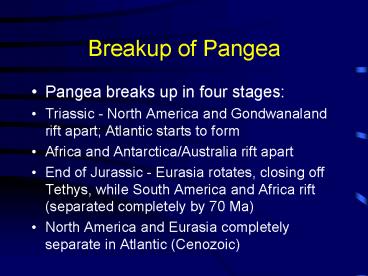Breakup of Pangea PowerPoint PPT Presentation
1 / 18
Title: Breakup of Pangea
1
Breakup of Pangea
- Pangea breaks up in four stages
- Triassic - North America and Gondwanaland rift
apart Atlantic starts to form - Africa and Antarctica/Australia rift apart
- End of Jurassic - Eurasia rotates, closing off
Tethys, while South America and Africa rift
(separated completely by 70 Ma) - North America and Eurasia completely separate in
Atlantic (Cenozoic)
2
West Coast of North America
- As the Atlantic grew, the Pacific began to shrink
- The Mesozoic saw lots of material added to the
west coast of North America - island arcs,
continental fragments - each of which extended
the continent a bit and tended to form mountain
ranges
3
West Coast of North America
- More than 50 distinct chunks (displaced
terranes) have been described in the Cordilleran
region - comprise 70 of the area - Some were so large that they just stuck on
others were just the lower-density material
riding on the oceanic crust that got scraped off
4
West Coast of North America
- New crust is not only these Pacific bits, but
also Andes-style subduction mountains, volcanism,
and sedimentary erosion
5
West Coast of North America
- Several main orogenic events
- Sonoma orogeny around the start of the Mesozoic -
volcanic arc crashes into coast - Nevadan orogeny in Triassic (and later in
Jurassic) - sediments weathering off mountains
get folded and crushed into new mountains
6
West Coast of North America
- Sevier orogeny - Middle Jurassic to Cenozoic -
east of modern Sierra Nevada mountains - lots of
low-angle thrust faults and folding - possibly
100 km of shortening along the coast - Laramide orogeny (Rocky Mountains) - high angle
reverse faults (become thrust faults with depth)
and folds deform the inner part of the continent
past the coastal margin
7
Dinosaurs
- Major classifications hinge on the number of
holes in the temple area of the skull (behind the
eyes) - Diapsida - two openings - includes dinosaurs,
flying reptiles, and all living reptiles except
turtles - Synapsida/Euryapsida - one opening - synapsids
low opening, euryapsids high opening - Anapsida - no openings
8
Dinosaurs
- Term coined by Sir Richard Owen in 1842 - means
terrible lizard - He only knew of three types Megalosaurus,
Iguanodon, and Hylaeosaurus - Since then there have been hundreds of species
discovered and described, so dinosaur is a very
broad term
9
Whats not a dinosaur?
- Dimetrodon
- Dimetrodon is a synapsid - not a reptile or a
mammal but earlier than both
10
Whats not a dinosaur?
- Pterosaurs
- These guys are definitely reptiles, but not as
closely related to dinosaurs - Not ancestral to birds or bats - this is a case
of convergent evolution
11
Whats not a dinosaur?
- Pterosaurs
- These guys are definitely reptiles and diapsids,
but are not true dinosaurs - Not ancestral to birds or bats - this is a case
of convergent evolution
12
Pterosaurs
- As pterosaurs get developed, they evolve into
more flight-adapted structures
13
Pterosaurs
- Big eyes, large brain, probably endothermic (wing
structures show thermoregulation)
14
Pterosaurs
- How did they get to fly? How did birds get to
fly? - Two ideas -
- Ground up hypothesis - organisms started on the
ground, began gliding behavior - Arboreal hypothesis - organisms started in trees,
developed gliding to accommodate transport (e.g.
flying squirrel) - Pterosaurs look like ground-up types from fossil
record
15
Triassic reptiles
- Many new reptile groups show up in the Triassic,
including turtles and early dinosaurs - One main group was the archosaurs - includes
crocodiles, pterosaurs, dinosaurs, and thecodonts
(dinosaur ancestors)
16
Thecodonts
- Small, agile, slight reptiles
- Many were bipedal - what are the advantages of
bipedalism? - Some revert to four-legged walking - again
convergent evolution toward crocodiles
17
Dinosaurs
- Two groups-
- Saurischia (lizard-hipped)
- Ornithischia (bird-hipped)
- First ones are about 225 Ma - Triassic
- Some saurischians are Theropods - big,
carnivorous dinosaurs including Allosaurus and
Tyrannosaurus.
18
Dinosaurs
- Another saurischian group is the Sauropods, large
herbivores. - Earliest were bipedal, but later they got huge -
e.g. Brontosaurus (now called Apatosaurus),
Supersaurus, Ultrasaurus (over 80 tons, 35 meters
long). Diplodocus and Seismosaurus - Can they live on land or in water?
- Sauropods first arrive in early Jurassic

